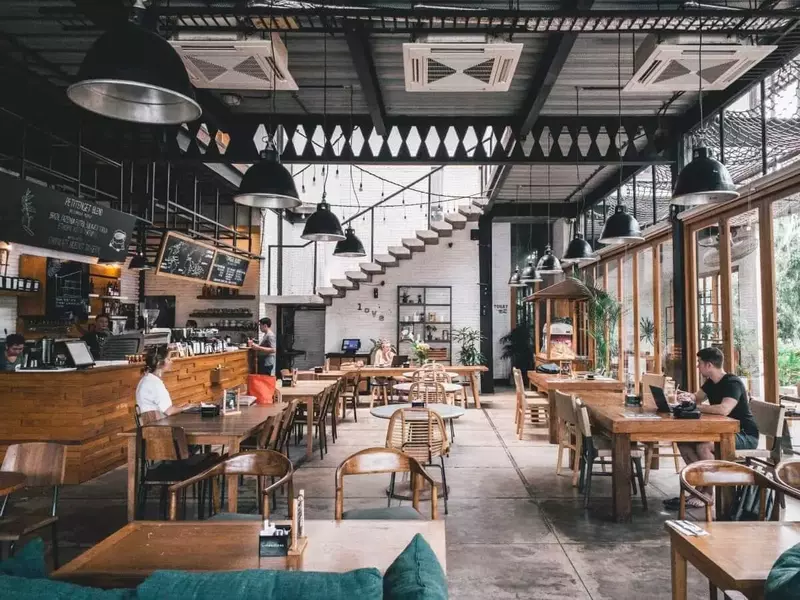The Financial Side of Running a Restaurant

Restaurant finances are a delicate balance: restaurant owners must provide high-quality food, pay their workers well, and deliver a top-notch dining experience while trying to save money and ensure great cash flow.
Running a successful restaurant requires great skill in managing finances, but fortunately, it’s entirely possible to learn how. Today, we’ll discuss the financial side of running a restaurant, particularly in the competitive Canadian restaurant business.
Starting with the Basics: Restaurant Financial Statements
Restaurant finances include various documents that outline cash flow, total sales, and operating expenses to give you a holistic perspective of your restaurant’s finances.
Each of these documents has a different purpose; bringing them all together will help you get an overview of how to improve in managing restaurant finances, as you’ll see where your money is going and what needs to change.
Profit and Loss Statement (Income Statement)
The Profit and Loss Statement, also known as the income statement, explains how much cash is coming into and out of your business through restaurant costs and sales reports. Here’s a breakdown of what you will find on this document.
Revenue and Gains: This explains operating revenue, non-operating revenue, and gains. Operating revenue includes gross profit and gross sales reports; non-operating revenue is things like profit from allowing others to advertise on your property for a fee or rental income.
Expenses: Your overall expenses include your prime costs, such as the cost to produce goods sold, employee wages, and utilities or rent. Non-prime costs are things like loan payments; you may also include losses due to lawsuits, one-time payments or purchases, and other expenses like mold remediation.

Net Profit
Once you’ve calculated your revenue and expenses, you come to your net profit: that wonderful number in your bank balance that you can use to buy new equipment, expand your business, and fund your own lifestyle as a restaurant owner.
Balance Sheet
The balance sheet is a snapshot of your business’s current assets and liabilities at a point in time; it can’t be used to analyze trends unless you compare it to previous balance sheets.
It’s based on a simple formula: assets equal liabilities and owner’s equity. This is because you need to pay for those assets, such as a building or equipment, through things like loans or your equity in the business. Both sides need to balance each other to show that you’re breaking even in regard to how much you are borrowing. Assets can include liquid funds, investments, inventory, and any updates to your equipment or restaurant technology.
Cash Flow Statement
Here, you are looking at cash flow: you want to have a positive cash flow in order to run a successful business. The cash flow statement is generally broken into operating activities, investing activities, and financing activities, which all come together to summarize your financial stability and give you an idea of how to better manage restaurant finances.
Negative cash flow is common in new restaurants, as there are a lot of upfront costs involved in starting up restaurant operations. However, if you see a consistently negative flow over a period of time, you need to find a way to control costs and reduce your expenses.
These documents form a crucial aspect of monitoring restaurant finances and helping you to hit your financial goals. You should analyze each of them in conjunction to get an idea of how to control costs and run a highly successful business over the long term.

Managing Costs Effectively
To manage restaurant finances, you need to gain control of your costs, which easily eat into your budget and reduce your total revenue. Fortunately, there are many strategies you can use in order to keep costs down and profits high.
Food Costs
Every restaurant needs to pay for the raw materials that make up their menu items, and it can be tricky to reduce these without sacrificing quality. However, you can find ways to improve your restaurant finances through lower food costs and still provide great customer satisfaction.
- Practice excellent inventory management by only buying what you need.
- Track food costs over time to see whether it might be best to substitute a pricy ingredient.
- Find local suppliers, who may be cheaper as they have lower transport costs.
- Negotiate pricing with vendors to see if you can get bulk discounts.
- Analyze food and beverage sales to see what doesn’t sell and eliminate it from the menu.
- Provide reasonable portions.
- Create daily menu specials that utilize leftover ingredients so they don’t go to waste.
Labor Costs
Labor cost is a prime cost associated with owning a restaurant, as well as a delicate balance: you want to pay your workers well without sacrificing your restaurant’s financial health in the process.
Many small business owners find it quite challenging to provide a competitive wage to their workers, but there are ways you can reduce this expense without harming your workers or your bottom line.
- Use scheduling software so that employees can submit their availability and receive an optimized schedule that satisfies everyone.
- Implement training programs to increase productivity and improve the customer experience.
- Pay attention to overtime, which can be very expensive; consider hiring part-time staff to help out.
- Build potential call-outs into the schedule so that you’re not short-staffed, which increases turnover.
Operational Costs

Your operational costs include everything involved in maintaining your restaurant space, including unexpected expenses like a broken water heater. These are generally more fixed costs that are difficult to pare down on, so it’s best to focus on simply managing them as best you can.
Here are some of the expenses included in operating expenses:
- Rent or mortgage
- Utilities
- Licenses
- Insurance
- Maintenance costs
- Lawnscaping if necessary
Budgeting efficiently involves preparing for each of these, as well as developing a safety net for sudden and unavoidable expenses. However, you can look for tax deductions and grants to help with modernizing your restaurant, or you might negotiate with your landlord for a lower rent.
Restaurant expenses are diverse and include a multitude of factors, each of which can be tweaked to improve your overall financial health and build a stronger positive cash flow.
Diversifying Revenue Streams
When you’re a new restaurant owner, you may believe that your revenue is one thing: total food sales. However, most restaurants actually have multiple revenue streams identified by the different services they offer, which include dine-in, takeout, delivery, catering, and merchandise. Each of these should be harnessed to their maximum potential in order to help your restaurant business reach the highest echelons of success.
Dine-in Sales
Whether you’re a fine dining restaurant or a quick service restaurant, everyone wants to have a great time when they go out to eat. Beautiful decor, a cozy atmosphere, and friendly staff can all boost your food and beverage sales for dine-in customers.
Takeout and Delivery
You may not even realize how many customers you’re missing out on by not providing takeout and delivery until you actually implement this service. It’s easier than ever to get started thanks to the many delivery platforms available, such as GrubHub, DoorDash, and UberEats, but you can also build your own in-house platforms, too.
If you set up a Google Business Profile, you can make it even easier for customers to get delicious meals from the comfort of their own homes, as it will automatically list the third-party providers you use. The easier you make it for customers to enjoy your services, the more likely they will be to choose you.
Catering Services

Many restaurants find great success by providing catering for corporate functions or special events; you can make hefty sales by giving only a small discount. If you have a large enough restaurant space, you may also find it advantageous to create a separate party room that customers can reserve for their special events.
Merchandising
T-shirts, hoodies, hats, stickers, and pins are a low-cost way to build more revenue, and they also are quite cost-effective; more than that, they make for great free advertising when a customer wears it out and about.
You might also consider selling signature products either in your restaurant or by partnering with a local grocery store. Baked goods, sauces, and prepared foods are an excellent way to diversify your revenue while also increasing brand recognition at the same time.
Loyalty Programs and Gift Cards
You may see loyalty programs and gift cards as an unnecessary expense, but they can actually be a crucial way to encourage repeat business and boost cash flow both in the short and long term. Even just one free drink after ten coffees will keep people coming back – and sharing the good news about your food and beverage options with their friends.
Accounting and Bookkeeping Best Practices for Restaurants
hen it comes to managing finances, you need a firm hand and consistent oversight to ensure that all is going as it should. Many businesses have been pulled under simply because they weren’t carefully monitoring their financial health and identifying problems right away. As such, you should keep these key practices in mind as you develop your financial plan for your business.
Daily Sales Reconciliation
When it comes to managing restaurant finances, you need to have a close eye on your sales reports so that you can identify discrepancies right away. Perform a daily business review where you run over all the numbers, check that everything has been tallied properly, and identify poor-performing products that will need to be watched closely in the future. While it takes time, it can help you see overall trends and quickly rectify any accounting errors.
Periodic Inventory Checks

Inventory management is a must, not just for the overall customer experience but to keep your costs down. Many restaurants use software that will help assess their inventory and identify when it’s time to order new stock, as well as identify products that are underperforming. Even if you don’t decide to use restaurant management software, commit to reviewing your inventory at least biweekly to see what isn’t selling well and what food costs can be eliminated.
Utilizing Accounting Software
Restaurant finances are a unique field, so it’s important to have tailored solutions that recognize the challenges and special requirements of a restaurant. There are numerous restaurant accounting software programs available that will help you manage your finances; they can also help during tax season by systematizing everything for easy returns.
Hiring Expertise
Even the most savvy restauranteur will not have all the specialized knowledge required for flawless accounting, which is why it’s incredibly helpful to ally with accountants who are familiar with the Canadian restaurant scene. They can assist you in identifying and rectifying discrepancies, monitoring cash flow, and navigating your tax requirements to ensure that you do not run the risk of liens on your business due to unpaid taxes.
Navigating Taxes and Regulations in Canada
Like other countries, Canada has a well-defined yet intricate tax system that requires careful study and application. Here are the most crucial factors you must keep in mind when managing restaurant finances.
Sales Tax
You will have to impose a sales tax on any goods sold, which is then used to fund the government. In order to do so, you need to register and put the money aside to be remitted to the government, either on a quarterly basis or more, depending on your sales volume. There are four different sales tax terms you should be familiar with, which vary across provinces.
Canada Goods and Services Tax (GST): The GST is a federal tax that applies across Canada; it must be imposed on anything used or consumed. This sales tax is 5% in every province. You only have to register if you make over $30,000 in four consecutive quarters, at which time you’ll register to take the GST/HST tax.
Harmonized Sales Tax (HST): For restaurants in Ontario, New Brunswick, Newfoundland, Nova Scotia, and Prince Edward Island, you’ll apply for the Harmonized Sales Tax, which rolls both federal and provincial taxes into one. The rates vary by province, but you’ll register the same way that you would for the GST.
Provincial Sales Tax (PST): This applies to British Columbia and Saskatchewan; it works very similarly to the Harmonized Sales Tax but simply shows up as a separate line. British Columbia imposes a 7% PST in addition to the GST, while Saskatchewan imposes a 6% PST.
Quebec Sales Tax (QST): Quebec also imposes its own sales tax on top of the GST, which is currently 9.975% in addition to the GST.

Payroll Taxes
Both employees and employers must pay payroll tax in Canada; this is used to pay for healthcare and other governmental costs. Your contribution also goes to pay for workers’ compensation, a necessity for all businesses. Both the federal government and provincial governments have payroll taxes.
To remit taxes, you will sign up with the Canadian Revenue Service, as well as the regional tax authority in your province; during this process, you’ll register for the Canada Pension Plan, Employment Insurance, and Workers Compensation. After that, you will need to set up a Canadian banking account and connect it to your CRA account so that the payroll tax can be remitted appropriately.
A payroll accountant can be very helpful here, as they will guide you through the process and ensure that you are properly remitting the necessary taxes.
Tax Deductions
Running a business is very expensive, but fortunately, you do have some ways to make back a bit of what you’ve spent: tax deductions. You will claim these on your returns each year and be compensated, which can then be put back into your account to pay for more expenses.
There are a number of deductions you can make, which include the following:
- Advertising
- Start-up costs
- Licenses
- Deliveries and freight
- Insurance
- Bank charges
- Professional services like accountants
- Maintenance and repairs
- Administrative fees
- Office expenses
- Property taxes and rent
- Telephone and utilities
- Travel
Preparing for Financial Uncertainties
Unfortunately, business doesn’t always go on as planned, so it’s important that you build a safety net into your restaurant’s financial plan so that you don’t experience undue hardship due to unexpected closures or property damage.
Emergency Funds
Just like consumers, businesses should also have about six months of funds in reserve to cover expenses should they experience a loss of income. Keep this in a high-yield savings account so that you can access it when necessary, but it will continue to profit for you when you don’t.
Insurance
Business insurance ensures that you’re covered if there are accidents or property damage on your premises. Liability insurance is important, as accidents happen in commercial kitchens all the time, but you should also consider equipment and property insurance that will help compensate you should your kitchen appliances fail.
Scenario Planning

Risk management is about identifying potential hazards and future events in order to prepare for them. While we can’t always predict every problem that may come our way – for example, the Covid-19 pandemic – some may be more predictable, like closures due to construction in front of your business. Take the time to brainstorm every possible problem that might arise, then develop an action plan to protect your restaurant’s finances in such a circumstance.
Conclusion
The journey to reach your financial goals while running a profitable restaurant can be long and hard, but careful financial management can make a huge difference in how your company shapes out in the long run. Being proactive and carefully analyzing your records will ensure you can intervene quickly should you identify problems and that you can build toward a brighter future for you and your employees.
References and Further Reading
“Understanding Profit Margins for Restaurants:” Sage Advice provides an overview of profit margins and what you can expect over the long term.
“Managing Restaurants During the COVID-19 Crisis: Innovating to Survive and Prosper:” This research article discusses the impact of the pandemic on Candian food and beverage companies, providing useful lessons on how to navigate and adjust to large-scale societal shifts.
“Manage Your Business:” BDC provides a wealth of resources for how to manage restaurant finances effectively.
“Why Fintech Is the Future of Restaurants: A Case Study:” Fintech.ca provides a glimpse into why financial management software is so crucial to Candian restaurant success.
Frequently Asked Questions
What Is a Good Profit Margin For a Restaurant?
Between 3% and 5% is considered food for a restaurant, though some may see it as high as 7% with great management.
How Can Restaurant Owners Improve Their Financial Management Skills?
There are numerous courses you can take that will help you improve your financial management skills, many of which are provided at low or no cost. CPC Canada lists a number of great resources to help you improve your financial literacy.
How Can I Ensure Success With Merchandising?
Merchandising can be daunting for many small business owners, but here are some tips to boost your chances of success:
- Perform test trials.
- Carefully research suppliers using reviews.
- Order in small batches at first and track their success.
- Partner with other local businesses to improve distribution, like grocery stores.
What Role Does Customer Feedback Play in Maintaining Healthy Restaurant Finances?
Customers can provide a wealth of feedback that will help you pinpoint problems. For example, you can analyze sales to see what isn’t performing well and can be safely removed from your menu, and you can also solicit feedback on staffing, pricing, and the overall restaurant experience to see how you might be able to improve.







